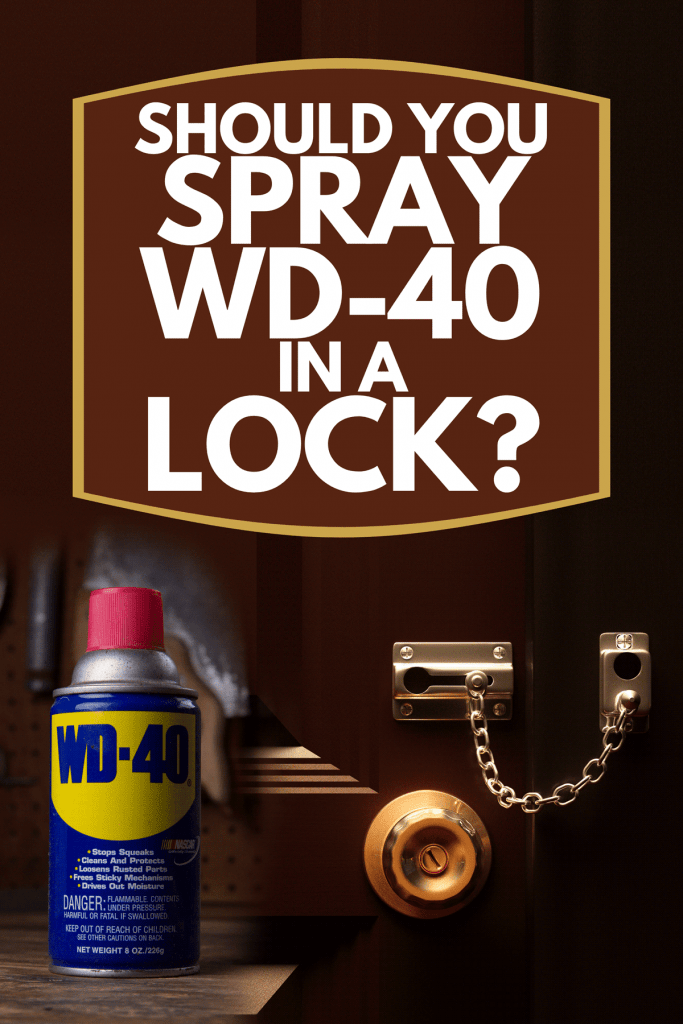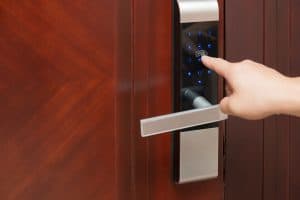Locks should always be functioning at their prime. But over the years, dust and grime make their way inside, affecting locks' performance. And depending on the situation and time of when they malfunction, we may have opted to try some home remedies. And many may be wondering if the popular WD-40 can be used to remedy problematic door locks. We pulled together what we found out.
While WD-40 has been used in almost everything, the multi-use product is not preferred to use for door locks. New products like WD-40 Gel Lube No-Drip Formula, Specialist Penetrant, and Silicone may have better outcomes when used. WD-40 multi-use product is a water and oil displacing solvent that can also remove the already present lubricant inside the lock. Prolonged use can leave the inside mechanism dry and susceptible to sticking.
There are other possible options to use when you find your locks uncooperative. But before we dive into that, let’s first discuss why WD-40 should not be your top-of-mind lubricant for your locks.

Why is WD-40 Product bad for locks?
When you hear WD-40, almost always, the first thing that comes to mind is its first-ever formula—the multi-use product. Since its introduction, it has been used to remove rust in metal surfaces, lubricate moving parts, loosen rusted bolts, and remove duct tape on almost any surface. The components are mainly LVP aliphatic hydrocarbons (45–50%), petroleum-based oil (<35%), aliphatic hydrocarbons (<25%), and carbon dioxide (2-3%).
It is basically a water-displacing solution, but it's not considered a true lubricant. It produces its lubricant effect by removing rust and corrosion. Inadvertently, it also dries up the inside of the door mechanism as it also removes the scanty lubricant present. A dry lock mechanism coupled with more grime and dust coming in can further gunk up your lock.
With the expansion to other product types, there may now be a suitable WD-40 to counter lock problems.
How do you loosen a stiff door lock?
A stiff door lock just needs to be lubricated. A true lubricant should be able to loosen mechanisms and make way for efficient interaction between functioning parts. It needs to be stable (high boiling point and low freezing point), oxidation resistant, and high viscosity index. One that is less likely to catch fire is also a plus.
When putting a lubricant on, whether it be powder form or liquid form, it is best that you only use a small amount. Start by putting a little on the key and then inserting the lubricated key into the keyhole. Too much lubricant can also form unwanted debris inside that can obstruct your locks.
Make sure to clean the key on a regular basis. Often, debris is introduced through the key. If possible, clean the key on a regular basis as sometimes dust can accumulate in the crevices.
Inactivity can also jam your locks. Make sure to test them when not regularly used—for rooms that are often not used, or in your second home when you visit. Early indications are a spring bolt does not come out spontaneously, a key that seems to get stuck, or a door handle that is difficult to turn.
What is the best lubricant for door locks?

Most locksmiths would profess to both graphite powder and Teflon-based lubricants. You may encounter mixed reviews for graphite powder.
Graphite powder comes in a small plastic bottle with a small nozzle that you can use to administer the lubricant straight to the keyhole. It has excellent properties as a dry lock lubricant which is ideal for new or cleaned locks. While it may be tempting to douse a lot, restraint is needed as you only need a small amount. It absorbs moisture readily so any excess can form gunk inside. This is especially challenging if the gunk develops within the pinning mechanism.
If you don’t have graphite powder and would need to lubricate the door on an emergency, you can use a pencil. Rub some pencil lead (which is made of graphite) into the key and insert.
Teflon-based lubricants are best. They are chemically inert, hydrophobic, and slippery when applied. It can prevent rusting and corrosion. And because it does not attract dust or dirt, there is a low likelihood of gunk build-up inside your locks. The active molecule is polytetrafluoroethylene (PTFE) and is available under several brands such as GT85, Tri-Flow, Lock Saver, and Dry Film.
Is PB Blaster good for door locks?
PB plaster is especially good for locks with corrosion, but not recommended as maintenance lubricant for your door locks. It has a strong odor so use at a minimum and keep a rag handy to wipe off excess amounts. As with other lubricants, it is advised to test a small amount by applying it to your key and inserting it into the mechanism.
Reviews have often compared it to WD-40, as they are marketed for almost the same purpose. But some view PB plaster as way better if the problem is rust but tend to sway more to WD-40 if moving pieces is a challenge, as it has more of the lubricant present.
Can I put olive oil in door locks?

It is not advised to drop olive oil directly into the keyhole. Also, olive oil is not the preferred lubricant to use as oils over time can collect dust and grime inside the key. Olive oil can solidify quite easily. So you may need to think twice before adding a drop or two during winter.
When in need of a quick fix, it is advised to put a small amount on the key before inserting it into the keyhole. Slowly move the key alternately to the right and left to loosen the mechanism.
How do you unfreeze a door lock?
To unfreeze a door lock, remove excess ice build-up outside the lock by wiping the ice away. Check the keyhole for any ice build-up by inserting the key. If you find some difficulty, you can opt to spray a small amount of de-icing spray into the keyhole. Once you’ve cleared the obstruction, you can also pre-heat the key to remove any small ice particles lingering.
Another substance that you can use to melt the ice build-up inside the keyhole is alcohol. You can wipe a small amount into your key before inserting it into the keyhole. The alcohol present in the hand sanitizer is also able to lower the melting point of water.
To avoid your door locks from freezing, it is advised to place a small amount of oil into your locks before the first sign of frost. You may also opt to cover the door handle to lessen direct exposure to snow, especially the keyhole so that ice is blocked from entering.
Take home message
It is always best to make sure that your door locks are well lubricated to prevent jamming. Choose a lubricant that does not encourage dust and grime build-up. Graphite remains to be one of the preferred lubricants together with silicone-based types. If you decide to use WD-40, make sure you get the right product type. If all else fails, then you may need to consult with your nearest locksmith to fully determine what’s causing the problem.



